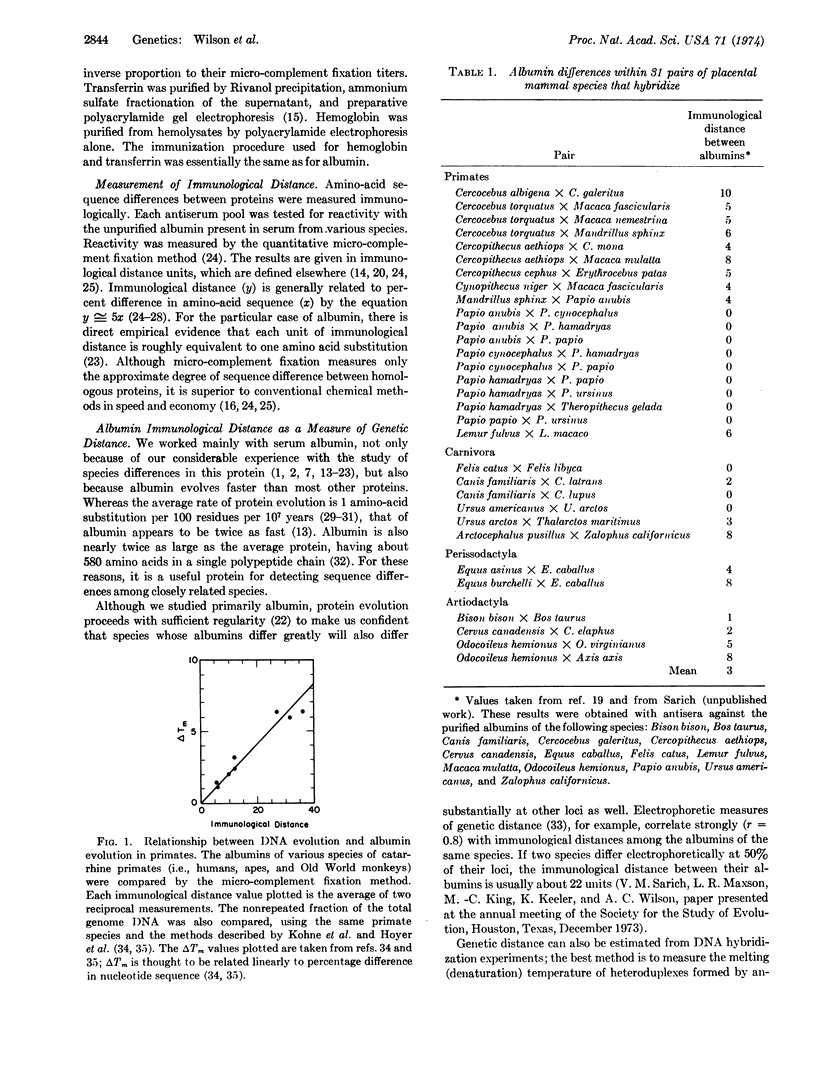Abstract
To assess the significance of macromolecular sequence differences among species, we compared the serum albumins of 81 pairs of vertebrate species capable of producing viable hybrids. Micro-complement fixation experiments showed that the average difference between the albumins within such pairs was only 3 immunological distance units for placental mammals (31 pairs), but 36 units for frogs (50 pairs). Albumin immunological distance is strongly correlated with other measures of genetic distance, including those made with DNA annealing techniques. It therefore seems likely that mammalian species pairs capable of hybridization are far more similar at the macromolecular sequence level than is the case for most hybridizable frogs.
We think the most likely explanation for the marked molecular restriction on hybridization among mammals is that the ratio of regulatory evolution to protein evolution is higher for mammals than for frogs. Mammals may have experienced unusually rapid regulatory evolution; indeed, this could be the factor responsible for their unusually rapid anatomical evolution.
Keywords: mammals, frogs, proteins, regulation, maternal-fetal immunology
Full text
PDF




Images in this article
Selected References
These references are in PubMed. This may not be the complete list of references from this article.
- Beer A. E., Billingham R. E. Immunobiology of mammalian reproduction. Adv Immunol. 1971;14:1–84. doi: 10.1016/s0065-2776(08)60283-7. [DOI] [PubMed] [Google Scholar]
- Blackler A. W., Gecking C. A. Transmission of sex cells of one species through the body of a second species in the genus Xenopus. II. Interspecific matings. Dev Biol. 1972 Mar;27(3):385–394. doi: 10.1016/0012-1606(72)90177-7. [DOI] [PubMed] [Google Scholar]
- Britten R. J., Davidson E. H. Repetitive and non-repetitive DNA sequences and a speculation on the origins of evolutionary novelty. Q Rev Biol. 1971 Jun;46(2):111–138. doi: 10.1086/406830. [DOI] [PubMed] [Google Scholar]
- Clarke A. G., Hetherington C. M. Immunogenetic aspects of maternal-fetal relations. J Reprod Fertil Suppl. 1972 Mar;15:99–118. [PubMed] [Google Scholar]
- Davidson E. H., Britten R. J. Organization, transcription, and regulation in the animal genome. Q Rev Biol. 1973 Dec;48(4):565–613. doi: 10.1086/407817. [DOI] [PubMed] [Google Scholar]
- Dickerson R. E. The structures of cytochrome c and the rates of molecular evolution. J Mol Evol. 1971;1(1):26–45. doi: 10.1007/BF01659392. [DOI] [PubMed] [Google Scholar]
- Hancock J. L., McGovern P. T., Stamp J. T. Failure of gestation of goat x sheep hybrids in goats and sheep. J Reprod Fertil Suppl. 1968 Apr;3(Suppl):29–36. [PubMed] [Google Scholar]
- Hsu Y. C. Differentiation in vitro of mouse embryos to the stage of early somite. Dev Biol. 1973 Aug;33(2):403–411. doi: 10.1016/0012-1606(73)90145-0. [DOI] [PubMed] [Google Scholar]
- King J. L., Jukes T. H. Non-Darwinian evolution. Science. 1969 May 16;164(3881):788–798. doi: 10.1126/science.164.3881.788. [DOI] [PubMed] [Google Scholar]
- MOORE J. A. Abnormal combinations of nuclear and cytoplasmic systems in frogs and toads. Adv Genet. 1955;7:139–182. doi: 10.1016/s0065-2660(08)60095-4. [DOI] [PubMed] [Google Scholar]
- McCarron K., Volpe E. P. Serological relationships of frogs (Ranidae) and toads (Bufonidae). Experientia. 1973 May 15;29(5):626–628. doi: 10.1007/BF01926709. [DOI] [PubMed] [Google Scholar]
- Ono S. Ancient linkage groups and frozen accidents. Nature. 1973 Aug 3;244(5414):259–262. doi: 10.1038/244259a0. [DOI] [PubMed] [Google Scholar]
- Prager E. M., Arnheim N., Mross G. A., Wilson A. C. Amino acid sequence studies on bobwhite quail egg white lysozyme. J Biol Chem. 1972 May 10;247(9):2905–2916. [PubMed] [Google Scholar]
- Prager E. M., Wilson A. C. The dependence of immunological cross-reactivity upon sequence resemblance among lysozymes. II. Comparison of precipitin and micro-complement fixation results. J Biol Chem. 1971 Nov 25;246(22):7010–7017. [PubMed] [Google Scholar]
- Rocha V., Crawford I. P., Mills S. E. Comparative immunological and enzymatic study of the tryptophan synthetase beta 2 subunit in the Enterobacteriaceae. J Bacteriol. 1972 Jul;111(1):163–168. doi: 10.1128/jb.111.1.163-168.1972. [DOI] [PMC free article] [PubMed] [Google Scholar]
- Sarich V. M. Generation time and albumin evolution. Biochem Genet. 1972 Dec;7(3):205–212. doi: 10.1007/BF00484818. [DOI] [PubMed] [Google Scholar]
- Sarich V. M. Pinniped phylogeny. Syst Zool. 1969 Dec;18(4):416–422. [PubMed] [Google Scholar]
- Sarich V. M., Wilson A. C. Generation time and genomic evolution in primates. Science. 1973 Mar 16;179(4078):1144–1147. doi: 10.1126/science.179.4078.1144. [DOI] [PubMed] [Google Scholar]
- Sarich V. M., Wilson A. C. Immunological time scale for hominid evolution. Science. 1967 Dec 1;158(3805):1200–1203. doi: 10.1126/science.158.3805.1200. [DOI] [PubMed] [Google Scholar]
- Sarich V. M., Wilson A. C. Quantitative immunochemistry and the evolution of primate albumins: micro-complement fixation. Science. 1966 Dec 23;154(3756):1563–1566. doi: 10.1126/science.154.3756.1563. [DOI] [PubMed] [Google Scholar]
- Sarich V. M., Wilson A. C. Rates of albumin evolution in primates. Proc Natl Acad Sci U S A. 1967 Jul;58(1):142–148. doi: 10.1073/pnas.58.1.142. [DOI] [PMC free article] [PubMed] [Google Scholar]
- Wallace D. G., Maxson L. R., Wilson A. C. Albumin evolution in frogs: a test of the evolutionary clock hypothesis. Proc Natl Acad Sci U S A. 1971 Dec;68(12):3127–3129. doi: 10.1073/pnas.68.12.3127. [DOI] [PMC free article] [PubMed] [Google Scholar]
- Wallace D. G., Wilson A. C. Comparison of frog albumins with those of other vertebrates. J Mol Evol. 1972 Dec 29;2(1):72–86. doi: 10.1007/BF01653944. [DOI] [PubMed] [Google Scholar]
- Wolpert L. Positional information and the spatial pattern of cellular differentiation. J Theor Biol. 1969 Oct;25(1):1–47. doi: 10.1016/s0022-5193(69)80016-0. [DOI] [PubMed] [Google Scholar]
- Zepp H. D., Conover J. H., Hirschhorn K., Hodes H. L. Human-mosquito somatic cell hybrids induced by ultraviolet-inactivated Sendai virus. Nat New Biol. 1971 Jan 27;229(4):119–121. doi: 10.1038/newbio229119a0. [DOI] [PubMed] [Google Scholar]



